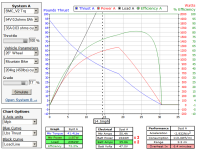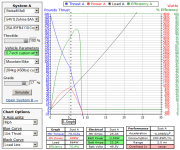encinitas said:
...a 17% grade hill that will be a part of nearly every ride...
I'm electrifying an old Schwinn tandem, about 50 lbs, and I weigh in at 215lbs. The tandem may be carrying another rider around 140bls, or just my surfboard. A 25 mile range is more than adequate (5-10 ) much more common, and max speed at 20m full throttle is fine.
The hill in question has about a 1/2 mile run and 385 ft rise. It's easy to use Grin Tech's simulator to find the speed/range numbers, but I'm worried about buying parts that will burn out on that hill. Is this a valid concern, and how can I address it by making proper build choices?
encinitas said:
OK, I soft-pedalled my question--I am definitely factoring it in, except I don't know how to factor it in. That's the guidance I am seeking!
...
But I'm trying to minimize my costs on this first bike, so I was heading toward a rear hub motor.
Realistically, 90% of it's use will be to go over that hill to get to the beach, a 5 mile round trip, 5-7 times a week.
So, again, I'm looking for feedback in terms of size of motor, or whether a hub motor is even viable for this use, etc.
Lots of opinions and options here - let's flog the simulator a bit and see what it has to say and what rings true...
Your projected load in 215+140+50 lbs plus the weight of the drive system - let's say another 40lbs plus 5lbs of locks and chains (so your bike won't get stolen at the beach) so a minimum of 450lbs.
To get some notion of your power requirements - before looking at specific motors and batteries, the simulator Load Line shows the score:
(I have used a Mtn bike profile, although the upright posture of a tandem should have a higher CdA - but at these low speeds, we take the simple preset instead of fussing too much)
View attachment 4
This is the power required to propel the bike at various speeds. Divide these figures by motor efficiency to get the battery power you need. So - we see that you would need 2450W of motor power to climb the hill at 15mph but only 400W to cruise at 20mph. This portion of the simulator relies on basics physics - not motor models - and is very accurate. Obviously the hill is the entire problem by a huge margin.
Before looking at specific motors, we can see that even at 10mph, we are looking at serious power - and small DD or even large gear motors are going to be in trouble because of the low loaded speed which will push them into very low efficiencies. Mid drives that yield only sub-10mph speeds (far too slow for hub motors to be efficient) look like a real possibility with only modest power requirements.
But - we want to see the true picture - so here's a run with a MAC 12T (BMC V2 Trq is equivalent) and a common 9C2807 as found in 1000W DD kits. The battery and controller for the 9C have been jacked way up to get the same rough performance as the MAC. This was done to simplify the plot - also the efficiency curves were omitted for clarity but you can see things look bleak even without the complete plot.

Here we see neither one has a chance - drawing about 2kW and 4kW battery power respectively and loosing the majority of that to heat at 33% and 16% efficiencies respectively. The Simulator 'Overheats In' estimate is conservative and assumes still air - but at 4mph it's a good indication that these will be smoked long before the hilltop at this low speed.
Bad choices.
This really should be sending you to the previous suggestions - really big DD, 2WD, or mid-drives.
Unfortunately the Cromotor was recently removed from the simulator since a sample motor was never submitted to verify the estimated simulation parameters - so that one is off the table for simulation. You can fiddle about with other big motors - but they will require fairly massive amps to be able to do the job. This is fine if you are going to jump into LiPo on your first bike - but if you are trying to be more conservative with an NCA battery from EM3EV or similar, then these brute force motors are not going to work out too well - you can't get the amps out of the battery. Here's a sample run using a big 5305. You can select different voltages and controller currents, but it's clear that this motor wants to go fast and is eating a fair bit of power. Since we are really just trying to get up this one hill, it would not be my choice - particularly because of the battery chemistry - others may feel differently.
View attachment 2
2WD gearmotors are a possibility. Here is a simulation with two MAC 12s:

To do 2WD analysis with the same motor and wheels, we just scrub the speed cursor to the right until the Load is twice the Motor Power.
This solution uses off-the-shelf stuff from EM3EV. Nothing Custom. I have reduced the controller current to only 35A (although 12FET controllers can deliver a great deal more with resulting higher speed) just to get the battery current draw down to 70A. Assuming we are using a
17.5Ah 14s9p triangle pack with INR18650-20R cells (10C) we might pull 10 x 17.5A = 175A derated by 50% or about 75-80A safely. Since speed is to the left of the discontinuous peak in the red Motor Power curve, we know that the motor power is controller-limited and that is the gating factor. The battery is a little saggy, so we might not get the whole 14.5mph, but it will definitely get up the hill. The added complexity involves bolting in a prelaced front wheel, bolting up a second controller, and running some wires. More stuff for sure, but...
Looking at 'Overheat In' we see that 6.4min / (60min/hr) x 14mph = 1.5mile range before the motors begin to overheat. This is a nice workable margin for a 1/2 mile hill.
This looks fairly attractive and delivers about 180lbs of thrust off the line which makes for a perky getaway.
The last option is a mid drive. An option is the
the StokeMonkey since you have the room in the tandem. Here the simulator gets a little more interesting because there is gearing involved. The SM has a 16 tooth gear. The biggest granny gear on a stock DNP freewheel is going to be 32 tooth, but obviously there are other options there since a regular cassette can be used. This leaves the Left/Right BB gears as the last ratio. If you use a 50T on the SM and a 22T chainring on the right, we have an overall ratio of 16/50 x 22/32 (or 16/32 x 22/50 if you look at it another way) = 0.22. Applying this to our 26" wheel we get an effective wheel diameter of 26 x 0.44 = 5.7 inches which we plug into the simulator.

This looks pretty darn good. It uses little power exactly as predicted in our initial LoadLine analysis and will climb forever without overheating. This means a much thriftier battery. You might play with the gearing to further improve the situation, but even this simple setup works well. I used a 54V EM3EV triangle pack for this run, looking to an easy mounting situation, but with the low currents, it could be a cheaper version with more capacity and a lower C rating for more range than the one used in the 2WD simulation. As with the 2WD approach, this approach has massive torque off the line. Temperature monitoring is not required and you could use a simple CA V2 or even cheaper Wattmeter to track your battery - more savings.
There are other mid drive options, but this shows at least one very robust off-the-shelf solution. From here you should be able to go back to the simulator and work out battery requirements and available max speeds for your choice.
I hope that I haven't fat-fingered a value in the simulator, but you get the drift of the procedures and can verify the stuff yourself.
Hope this helps...



![800px-DunedinBaldwinStreet_Parked_Car[1].jpg 800px-DunedinBaldwinStreet_Parked_Car[1].jpg](https://endless-sphere.com/sphere/data/attachments/82/82991-12633e28ea464b210da596fce25d9975.jpg)
![Eldred-Street_Steep-street_13324[1].jpg Eldred-Street_Steep-street_13324[1].jpg](https://endless-sphere.com/sphere/data/attachments/82/82992-41236a96291b9f216b1298af0ce5a1f6.jpg)


